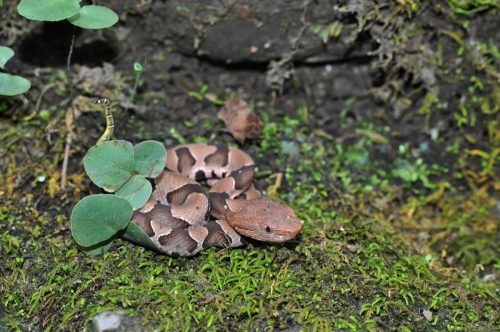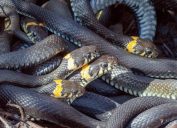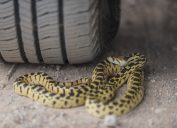If You Live Here, Watch Out for Venomous Snakes for the Next Month
One particular snake will be more prevalent here throughout November.

Snakes are often a scary sight on their own, but there is an increased amount of danger when dealing with a venomous snake. According to the Centers for Disease Control and Prevention (CDC), there are four types of venomous snakes found in the country: rattlesnakes, copperheads, cottonmouths, and coral snakes. The agency estimates that 7,000 to 8,000 people are bitten by venomous snakes in the U.S. each year. And the risk of a bite will be even higher for residents of one state, as local experts are warning that a venomous snake will be more prevalent throughout the month of November. Read on to find out if you need to be on the lookout.
RELATED: 5 Cleaning Habits That Attract Snakes.
Tennessee officials say residents are likely to see more copperhead snakes right now.

The Tennessee Valley Authority (TVA) recently posted a warning on its Facebook page, advising Tennessee residents that they are likely to see more copperhead snakes right now. "From now through November, it is baby copperhead snake season," the TVA wrote in its Oct. 13 post.
McKenzie Strickland, a herpetologist for the Tennessee Aquarium, confirmed to WRCB, a NBC-affiliate in Chattanooga, Tennessee, that now is the time in which these snakes are going to be giving birth to live young. According to Strickland, copperhead snakes "have about seven on average in a given clutch."
RELATED: 5 Things in Your Yard That Are Bringing Snakes to Your Home.
You should be extra vigilant if you're spending time outdoors.

Tennessee residents spending time outdoors during the next month should be especially cautious. "You're going to be able to see a lot more snakes out and about right now—especially if you're hiking or in a forested area or around some rocks," Strickland told WRCB.
According to the TVA, baby copperheads tend to be found in damp places, like logs on a trail or flowerpots in homeowner's yards. "If you are hiking or walking, be sure to look carefully where you step or place your hands," the organization warned.
If you come across a snake, there are a few ways to tell whether or not you're dealing with a copperhead. According to Strickland, copperhead snakes have both an identifiable head shape and pattern. "They have kind of a triangular-shaped head, which is something that's pretty well-known across venomous snakes," she told WRCB. "The pattern is kind of hourglass-like … unlike that of a corn snake or northern water snake that often get mistaken for a copperhead."
Experts say baby copperheads can be even more dangerous than adults.

Both adult copperheads and baby copperheads are venomous. According to Live Science, copperhead snakes are different from other venomous snakes in that they tend to give no warning signs and strike to bite almost immediately when they feel threatened. But experts say an influx of baby copperheads might be even more dangerous than adult snakes.
"Young copperheads are actually more likely to be more potent than what you'd experience with an adult because they don't know necessarily how much venom to release at the time of bite," Strickland told WRCB.
Babies also tend to have a distinct look too. "If you see a juvenile, they have a bright yellow lure on their tail that attracts their prey, so if you see that bright yellow lure they're the only species that has that," Strickland said.
RELATED: For more animals to avoid, sign up for our daily newsletter.
You should seek emergency treatment if you've been bitten.

The North Carolina Cooperative Extension at North Carolina State University says that copperheads snake bite more people than any other U.S. snake species, as reported by CBS News. According to Healthline, copperhead snake bite symptoms can include immediate pain, changes in skin color, shock, low blood pressure, and weakness.
Fortunately, copperhead snake venom is mild and rarely fatal. But as with any venomous snake, fatalities can occur. "Any venomous snake can be dangerous with neurotoxic complications and problems with blood clotting," Joann Schulte, DO, a medical epidemiologist who has researched snake bites, told CBS News in 2016. So if you have been bitten or think you have been bitten, you should seek emergency treatment as quickly as possible, per Healthline.
RELATED: You're Inviting Snakes to Your Home If You're Storing This Right Outside.





















